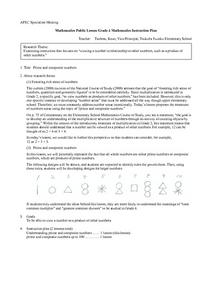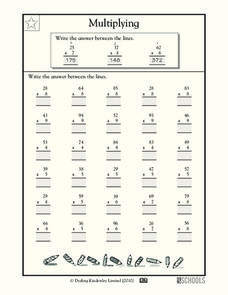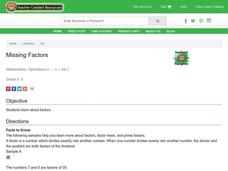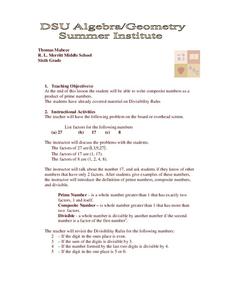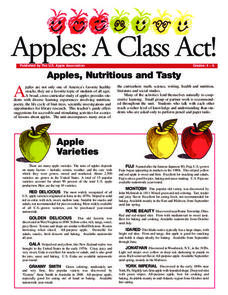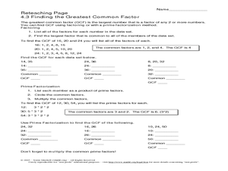Curated OER
Fascinating Factors
Learners observe biotic and abiotic things participating in an observational walk outside the school. They create a collage using pictures of biotic and abiotic items.
Curated OER
Find Factors of a Number
In this finding factors practice worksheet, students sharpen their problem solving skills as they solve 6 story problems.
Curated OER
The Product and Quotient Rules
In this product and quotient rules worksheet, students use Taylor's Theorem to rewrite functions in a given form. They determine the derivatives of functions. This three-page worksheet contains explanations, examples, and seven problems.
Curated OER
Prime And Composite Numbers - Fuzoku Elementary
Fourth graders investigate the concept of prime and composite numbers. Students study the visual representation for the numbers and use the pictures in order to develop designs for larger numbers. The goal of the lesson is for them to...
Curated OER
Soybeans: The Miracle Seed
Students discover why soybeans are called the "miracle seeds." They make their own soynuts and share other foods made from soybeans. They create a bulletin board of soybean products.
Curated OER
Multiplying
What is the product? Scholars solve 30 multiplication practice equations where one factor has two digits and the other has one digit. All are aligned vertically, and several require regrouping. There are three examples to remind scholars...
Curated OER
Urban Ecosystems 2: Why are There Cities? A Historical Perspective
Second in a series of five lessons, this lesson encourages preteens to consider cities as urban ecosystems. First, they keep a food diary for a few days. They visit the Natrional Agricultural Statistics Service website for current data...
Curated OER
A Yen for Maximum Residue Limits in Food
Future public health officials or agriculturists read an article and answer questions concerning the Japanese regulations for pesticide exposure. They compare the maximum residue limit for two, 4-D of Japan with other countries. This is...
Curated OER
Smiling at Two Digit Multiplication!
How do I solve a two-digit multiplication problem? Your class tackles this question by walking through problem solving methods. They first investigates and applies traditional multiplication methods, and they then compare those with...
Curated OER
The Foundation of Economics
This is a one-stop shop as an introduction to Economics; review 53 slides covering the basics of most economics principles with images and instructor notes. Journey from Adam Smith and the foundation of modern economics to concepts such...
Curated OER
Exploring Products of Fractions
Learners solve six multiplication problems, in simplest form, then answer four questions about the products of two fractions.
Curated OER
Missing Factors
Students explore factors. They discuss factors, factor trees and prime factors. Students practice working with and finding various factors and prime factors. They discuss methods used to find factors.
Curated OER
Exploring Multiplication Functions
Fourth graders investigate the terms "factor" and "product." In this mathematics lesson, 4th graders practice solving problems to find the products and factors present in different algebraic expressions.
Curated OER
Prime Numbers and Factors
Solving factor trees is a helpful way to introduce prime numbers. Your math class practices using this method along with two-column tables to find if a number is prime or not. They also learn other vocabulary, such as composite numbers,...
Lane Community College
Review Sheets: Basic Mathematics 1
Here is a worksheet that is 3/4 fraction practice and 1/4 skills guide. The problems are organized by concept and each section bullet points the skills needed to accomplish them. The problems are straightforward practice with word...
US Apple Association
Apples: A Class Act! (Grades 4–6)
Middle schoolers have a bushel of fun as they engage in activities and research core facts about apples. Packed with suggestions for in-class activities and out-of-class research, the colorful 6-page packet is sure to satisfy hungry...
Curated OER
Production Methods
High schoolers examine the different methods of production. They relate the new concepts to different production contexts. They identify the external factors that influence firms.
Curated OER
Teddy Bear Multiplication
A colorful presentation on basic multiplication problems awaits your class. Learners solve a variety of problems and match their answers with the choices on each slide. This basic and brightly colored resource is good for the younger set.
Norm Mitchell
Reteaching Page 4.3 Finding the Greatest Common Factor
A bit of instruction on how to find the greatest common factor opens the worksheet. Leanrers are then given three practice pairs of numbers. Then the assignment goes on to describe prime factorization, and also provides three more...
Curated OER
Production and Costs
Young scholars discuss the concept of productivity and participate in an activity in which they test their own productivity in making Origami cups. Teams determine how to improve productivity and then discuss factors that influence...
Curated OER
Factoring Polynomials
In this factoring activity, learners find the common term, use special products or use the diamond method to factor polynomials. Explanations and examples are provided. This three-page activity contains 45 problems. Answers are provided...
Curated OER
Solving Polynomial Equations by Factoring
Use the principle of zero product to solve these polynomial equations. There are 21 problems in various forms to solve. Some are already set to equal zero, but might needs to be put in descending order. Then there are sunsequent problems...
Illustrative Mathematics
Equivalent Expressions
Here is a straight-forward problem of multiplying two binomials with a twist. It is up to algebra learners to decide how to turn this product of sums into a sum of products. However, it is not the quadratic that is the answer; it is the...
Curated OER
Multiplying
There is a step-by-step example here to help young multipliers solve 12 equations, all of which have one 2-digit and one 1-digit factor. The method displayed encourages breaking the two-digit number into tens and ones, multiplying each...





